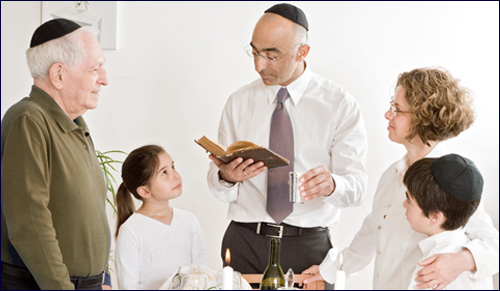Two Parts Of Shabbat
Every Jewish soul was present at Har Sinia (Mount Sinai) when Hashem (God) gave us the Torah. So YOU were there too! Do you remember?
When Hashem gave Bnei Yisrael the command to keep Shabbat, He did something no human being can do. Our Rabbis tell us that Hashem said two words simultaneously! The Aseret Hadibrot (ten commandments) are written in the Torah two times. The first time it says “Zachor et Yom Hashabbat – remember the day of Shabbat” and the second time it says, “Shamor et Yom Hashabbat – safeguard the day of Shabbat.”
One Utteracne
But which one did Hashem say at Mount Sinai? The answer is that He said both words: “Shamor” and “Zachor” bedibbur echad, in one utterance! And an even greater miracle took place: us humans made of flesh and blood were able to hear both! Why was this done? This is because both aspects of Shabbat are crucial for getting the whole package, and one aspect of Shabbat without the other is incomplete.
Zachor And Shamor
Zachor is a reference to the positive commandments of Shabbat, and Shamor is a reference to refraining from forbidden actions. Hashem expressed these simultaneously, teaching us that it is only with the full observance, being careful with both the positive commandments and the prohibitions that we can connect to Hashem on Shabbat.
Someone who says he wants to have a nice Shabbat meal but is not ready to commit to abstaining from melachah (doing creative work), will not get the full benefit of this wonderful day. Conversely, someone who just sleeps in bed and doesn’t do any work, but also doesn’t recite kiddush, will be missing out as well.
For this reason it is customary to light at least two candles before Shabbat, corresponding to these two dimensions of Shabbat. This is also why we bake challah in braids, demonstrating that these two dimensions of Shabbat are intertwined, and each one complements the other. But wait! Why was Zachor written in the Torah first and Shamor only later?
The Meshech Chochmah explains that these two aspects of Shabbat were emphasized at different periods of the Jewish Nation.
While In The Desert…
If we take a closer look at how the Jews lived during their forty years in the midbar (desert), we can understand why the focus at Har Sinai – the first time this phrase was said, was on Zachor. In the midbar, Bnei Yisroel (the Jewish Nation) did not have to work or run businesses. Hashem gave them manna to eat, water from a well, and clouds to protect them. They didn’t have to worry about making a living, and they spent their time learning Torah.
They were in an elevated state, and there was little concern that they would become pre-occupied with business. They did not have a challenge to stop doing melachah (doing creative work) once Shabbat arrived, so they were told about Zachor – the positive commandments.
While In Ertz Yisroel…
However, in Sefer Devarim, as Moshe Rabbeinu (Moses) is reviewing the entire Torah with the Jewish nation, in preparation for their grand entry to Eretz Yisrael (Israel), there was a different focus. Life was about to change for Bnei Yisrael. They had to plant fields, build homes, and earn a living. Now that they were about to live in a physical world with jobs and responsibilities, they needed to be warned to guard the holiness of the day by not slipping into weekday thinking or mundane pursuits.
That’s when the second part of Shabbat – Shamor, became more important to stress. They would have to ensure they would keep the day clear of weekday activities. This Shamor aspect of Shabbat would help them stay connected to their true purpose as a holy nation. Understanding both aspects of Shabbat is integral to our making the most of the holy day.
The Source Of It All
The Torah commands us, “Zachor et yom haShabbat l’kadsho,” “Remember the Shabbat day to make it holy”.1 The mitzvah of Zachor refers to all the mitzvos of Shabbat that we actively do, as opposed to what we refrain from doing on Shabbat.2
Zachor includes three main mitzvos of Shabbat: lighting candles, making kiddush, and saying havdalah. These are all part of the Torah obligation of zachor. But the mitzvah of zachor really includes much more. Anything you do to honor Shabbat (kavod Shabbat) and enjoy Shabbat (oneg Shabbat) counts!
Shabbat represents our belief that Hashem created the world and continues to sustain it every second. This is so important that it was the first mitzvah given to the Jews after Yetziyat Mitzrayim (exodos)!3 Since Shabbat is the source of our emunah (faith in God), it is considered equal to all the other mitzvot!4
All Week Long
Instead of saving this fundamental mitzvah for only one day a week, we can keep it all week long. How? Every day, when we say in davening, “Today is the first (or second…) day toward Shabbat,” we fulfill the mitzvah of Zachor by remembering what we’re headed toward. Another way to fulfill the mitzvah of Zachor during the week is through honoring Shabbat by saving the best things we come across for the holy day of Shabbat.5
Excerpted from Oorah’s Torah Nuggets
Zachor Et Yom Hashabbat: – Sources:
1 Mishna Torah, Shabbos 29a
2 Ramban, Shemos 20:8
3 Aruch HaShulchan OC 242
4 Ramban Yisroh 20:8
5 Rashi Shemos 20:8, quoting Beitza 15a


